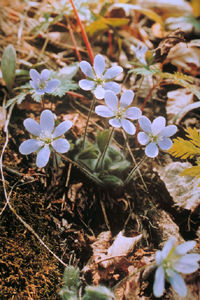Biodiversity is the variety of life (genetic, species and ecosystem levels) on Earth or some part of it. It includes all living forms, plants, animals and micro-organisms. It is the natural wealth of a region that provides resources and ecological services. But biological resources comprise only a small fraction of the biodiversity - biodiversity is all-encompassing.
Canada's Biodiversity
Despite its northerly position, Canada is rich in diversity because of its size (some 10 million km2 land and freshwater and 6.5 million km2 marine waters), varied environments (see Natural Regions), topographies and climates. Ecosystems include temperate rain forest treetop canopies, prairies, tundra, soil types, rivers, tide pools, kelp forests, 2 m thick sea ice and deep-sea hydrothermal vents.
There are 71 000 species described by science in Canada (excluding viruses), while another estimated 69 000 species remain to be named and classified by scientists, or recorded for the first time. If viruses are included, the number of estimated species would be doubled. About 51% of Canada's species are terrestrial, 23% freshwater and 25% marine. If we look at the higher groupings, like phyla, then 66% occur on land, 72% in freshwater and 84% in marine waters. The finer twigs of the tree of life are land-dwelling, while the major branches are marine. There are probably several thousand species at risk (vulnerable, threatened or endangered) or already lost (extirpated or extinct).
Benefits
In 1990, biological resources, the part of biodiversity that people directly use, were determined to be worth some $70 billion, even before much value is added. Biological resources include timber, agricultural crops, sport fisheries, blueberries, wild mushrooms, maple syrup, antibiotics, beer, bread and insect pollination ($1 billion). Biodiversity sustains much of our tourist industry. A host of new biotechnological and pharmaceutical products are being developed from living genetic resources, eg, cancer-combating taxol from the western yew, hitherto considered a weed tree by foresters.
Just as important as directly used biological resources are the indirectly beneficial ecological services. Ecological services include water purification, flood control, production of oxygen, pollination, provision of habitat for other species, soil creation and recycling of plant nutrients. The value of ecological services is difficult to grasp, but essential for local and planetary support services and human survival.
Threats
Biodiversity is being lost through several processes. These include habitat loss (deforestation and plowing down of the prairies), over-harvesting of resources, pollution (acid rain, eutrophication), introduction of exotic species (zebra mussels), urbanization, fragmentation of habitat (proliferation of roads), global warming and others.
The root causes include growth of human populations, high levels of resource use, greed, ignorance, inappropriate resource use and industrial practices. New ecological approaches to agriculture, forestry, fisheries, manufacturing and consumer consumption offers practical yet environmentally friendly solutions.
Canadian Initiatives
Canada was a lead player in the development of the International Convention on Biological Diversity; the first country to sign it and the first developed country to ratify it (1992). This momentous international agreement deals with conservation of biological diversity, sustainable use of its components and the fair and equitable sharing of benefits derived from them.
In 1996 the federal and provincial governments, nongovernmental and trade organizations and other groups released an agreement on how to achieve the goals of the Convention. All levels of Canadian society contribute to implementing the Convention in Canada. A new piece of federal legislation on endangered species and their habitats is being developed. Federal and provincial protected area legislation helps save representative ecosystems on land, in freshwater and the ocean - the latter as yet poorly represented. At the grass-roots level, environmental organizations have an important track record. They are active in public awareness and education, conservation, ecologically sustainable use and other areas.
Research
The basic knowledge needed for biodiversity conservation, sustainable use, new technologies and education is produced by natural history museums, universities, government departments and environmental organizations. As less than half of Canada's species are scientifically described and we know the ecological requirements of only a few species, much research is needed.
Biodiversity is Canada's most valuable heritage.
See also, Biosphere Reserves;Canadian Nature Federation; Cosewic; Endangered Animals; Endangered Plants; Environmental and Conservation Movements; Parks, National; Parks, Provincial; and World Wildlife Fund Canada.

 Share on Facebook
Share on Facebook Share on X
Share on X Share by Email
Share by Email Share on Google Classroom
Share on Google Classroom





